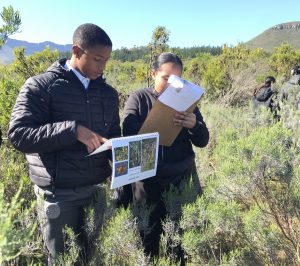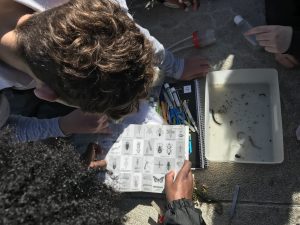On 30 July 2024, a group of 40 Grade 8 and 9 learners from Delicuim Academy, in Stellenbosch, took to the foothills of Stellenbosch Mountain to examine food webs in fynbos and renosterveld ecosystems.
The practical started with a short introduction to abiotic factors and ‘who eats whom’ in ecosystems, whereafter the learners ̶ equipped with tools and curiosity ̶ surveyed designated quadrants and categorised the species they found into the different components of a food web.
Using photo guides, the learners identified several plants as primary producers, and it included species from the genera: Passerina, Dicerothamnus, Oxalis, Pinus, Cliffortia, Dodonea, and a few geophyes.
One organism that had the learners debating, was the Drosera species they found in some of their quadrants. These plants, commonly known as sundew, are both producers and consumers. With their shiny green and sticky leaves, these species make their own food but also eats the insects that gets trapped in the sticky leaves.
After a search under rocks and in bushes, the learners found a few invertebrates and discovered that it is much more difficult to identify and to categorise invertebrates. The learners identified most of the invertebrates as being consumers, but it was harder to tell which ones are primary consumers and which secondary consumers.
Some of the groups were also lucky enough to stumble across decomposers in their quadrants, including mushrooms on dead logs and lots of earthworms in the soil.
Another organism that had learners wondering, was the moss they found growing on the wet rocks and soil. At the end of the day, they discovered the moss being a both a producer as a decomposer.
It was a lovely sunny day of learning in the field. By seeing the different organisms in their natural surroundings, the learners got a better understanding of the interdependencies within ecosystems and the roles of producers, consumers, and decomposers in fynbos and renosterveld.
 |
 |